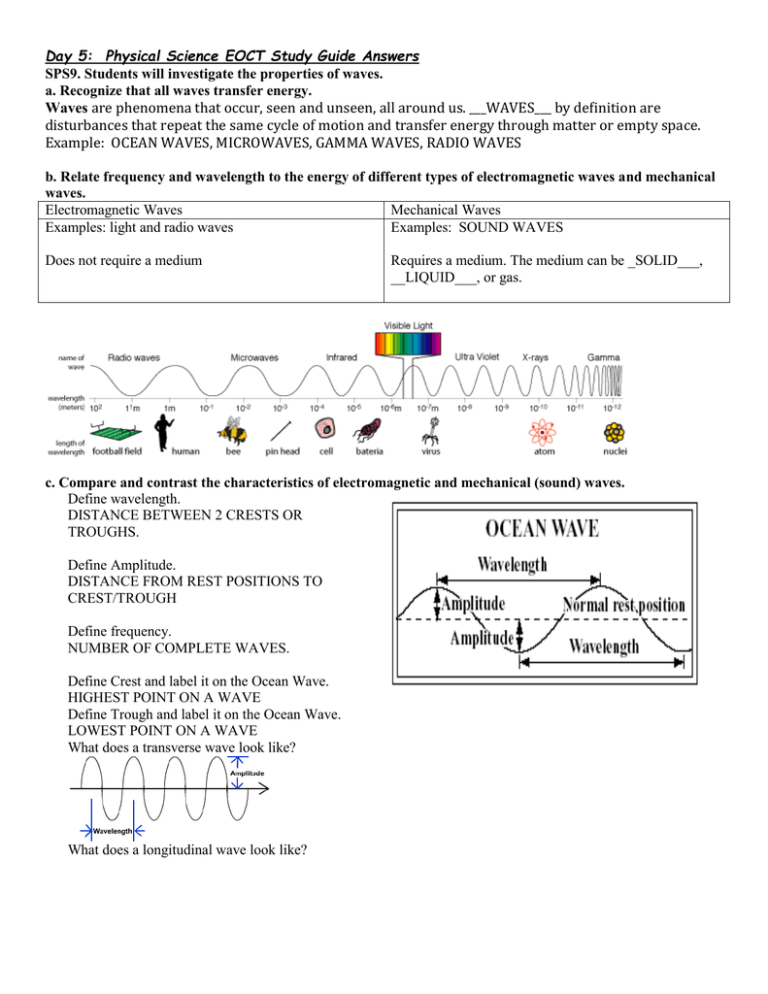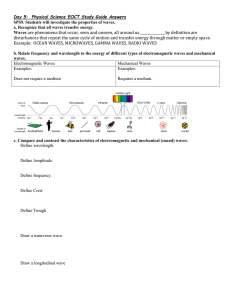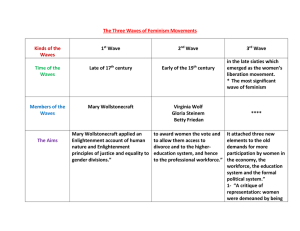SPS 9 _ 10 SG Answers
advertisement

Day 5: Physical Science EOCT Study Guide Answers SPS9. Students will investigate the properties of waves. a. Recognize that all waves transfer energy. Waves are phenomena that occur, seen and unseen, all around us. ___WAVES___ by definition are disturbances that repeat the same cycle of motion and transfer energy through matter or empty space. Example: OCEAN WAVES, MICROWAVES, GAMMA WAVES, RADIO WAVES b. Relate frequency and wavelength to the energy of different types of electromagnetic waves and mechanical waves. Electromagnetic Waves Mechanical Waves Examples: light and radio waves Examples: SOUND WAVES Does not require a medium Requires a medium. The medium can be _SOLID___, __LIQUID___, or gas. c. Compare and contrast the characteristics of electromagnetic and mechanical (sound) waves. Define wavelength. DISTANCE BETWEEN 2 CRESTS OR TROUGHS. Define Amplitude. DISTANCE FROM REST POSITIONS TO CREST/TROUGH Define frequency. NUMBER OF COMPLETE WAVES. Define Crest and label it on the Ocean Wave. HIGHEST POINT ON A WAVE Define Trough and label it on the Ocean Wave. LOWEST POINT ON A WAVE What does a transverse wave look like? What does a longitudinal wave look like? d. Investigate the phenomena of reflection, refraction, interference, and diffraction. Reflection Refraction Interference Diffraction occurs when a wave takes place when a wave occurs when two or more results when a wave passes hits an object that it passes from one waves arrive at the same point through a hole or moves cannot pass through it medium into another at at the same time past a barrier and spreads bounces off the object an angle and bends out in the region beyond the or medium boundary. (changes direction) due Illustration: hole or barrier to a Constructivechange in speed Illustration: Illustration: Illustration Destructive- e. Relate the speed of sound to different mediums. Sound travels faster through solids and liquids than it does through gases because particles are __COMPACT_ together in solids or liquids than in gases. Sound also travels fastest through elastic materials. f. Explain the Doppler Effect in terms of everyday interactions. When a sound source moves toward a listener, the pitch, or apparent frequency, of the sound increases. This is because the sound waves are compressed closer together and reach the listener with a higher pitch. As the sound source passes by the listener and moves away from the listener, the same sound waves are stretched farther apart. This results in a decrease in the pitch, or apparent frequency. This phenomenon is known as the ___DOPPLER_____ ___EFFECT___. It can be heard at a train crossing every time a train approaches, passes, and leaves a crossing while blowing its whistle. SPS10. Students will investigate the properties of electricity and magnetism. Electricitya. Investigate static electricity in terms of ___STATIC_____electricityresults from the buildup of electric charges on an object. The buildup of charges can be caused by friction, conduction, or induction. friction induction conduction RUBBING 2 OBJECTS TRANSFER BY NOT TOUCHING! ELECTRONS FLOW THROUGH TOGETHER DIRECT CONCACT b. Explain the flow of electrons in terms of alternating current- electrons changed direction at regular intervals. o Example: Gas driven generator or lights in your house direct current-electrons move in same direction. o Example: Batteries in your car or batteries in your flashlight Voltage (V) To get electrons flowing through a circuit, a voltage (V) is applied. Voltage, which is measured in volts (V), is the potential difference in electrical potential energy between two places in a circuit. In other words, voltage is the energy per unit of charge that causes charges to move. Type of circuit illustrated: Series Define: Ohms Law: V = IR Current (I) When charged particles flow through the wire in a circuit, an electric current (I) results. The current is measured in amperes (A). The electron is the charged particle that most likely moves through the circuit. Resistance (R) The opposition to current is called resistance (R), which is measured in ohms (Ω). Light bulbs and resistors are examples of objects with a resistance. Type of circuit illustrated: Parallel Define: Only 1 path to flow. 2 or more branches to flow. Examples: Examples: Flash light House c. Investigate applications of magnetism and/or its relationship to the movement of electrical charge as it relates to An electric current will also produce a magnetic field. A magnetic field is a region around a magnet or currentcarrying wire where magnetic forces can be measured. ___magnetism___ is the force of attraction or repulsion that is produced by an arrangement of electrons. Magnets have two poles: a north pole and a south pole. Unlike magnetic poles attract each other, while like magnetic poles repel each other. Groups of atoms with magnetic poles aligned are called magnetic domains. Materials with most of these domains lined up are considered magnetized. When a metal bar or other object is composed of stable, magnetic domains, a ____permanent________ magnet results. When an electric current is used to produce a magnetic field in a coil of wire, the coil becomes an electromagnet. A rotating electromagnet is used in __electric____ motors to convert electrical energy to mechanical energy. When a magnet is moved near a wire, an electric current is generated. This process, called electromagnetic induction, is used to operate a __generator___. A generator is a device that converts mechanical energy to electrical energy. In a commercial generator, an electric current is produced when a large coil of wire is rotated in a strong magnetic field. This picture illustrates ______________ ______electromagnet_______. This picture illustrates_______________ _electric motor____.




